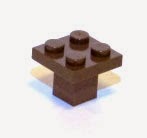The Lego / D&D Project: Part 2
Last post we looked at some simple Lego ideas for chairs. As a companion to that posting, let's look at the next logical piece of gaming scenery -- the table.
A table can be just as simple as a chair, all you really need is some size brick and a slightly larger plate (or tile).
You can make small tables using just 1x1 bricks and 2x2 plates, and thankfully these pieces come in almost every possible color you could want, but I find this structure is usually top heavy and doesn't stand up well to the casual dings a gaming table can take during a game session.
 If you really need a small table like this, consider using a Scala Base brick, as the "feet" on the bottom of the piece provide a bit more stability.
If you really need a small table like this, consider using a Scala Base brick, as the "feet" on the bottom of the piece provide a bit more stability.
But more common tables are 4x4, 4x6, or 4x8. And with these, you have some options for the table base, either just a simple brick (like a 2x2 or 2x4 underneath the tabletop, or 1x1 bricks for legs, 1x1 round bricks, archs, or even stacking 1x1 round plates for effect.
Like we did with the chairs in the last post, you can use tiles to make the tables look less lego-y. In this case, you can use 1x4 tiles to make the top look smooth.
And for longer tabels, you may want to consider benches, instead of chairs. As you can see, benches are much easier to build than chairs.
Also, if you visit the Citizen Brick website, you can get printed 1x4 and 1x6 tiles that look like wooden boards.
A table can be just as simple as a chair, all you really need is some size brick and a slightly larger plate (or tile).
You can make small tables using just 1x1 bricks and 2x2 plates, and thankfully these pieces come in almost every possible color you could want, but I find this structure is usually top heavy and doesn't stand up well to the casual dings a gaming table can take during a game session.
 If you really need a small table like this, consider using a Scala Base brick, as the "feet" on the bottom of the piece provide a bit more stability.
If you really need a small table like this, consider using a Scala Base brick, as the "feet" on the bottom of the piece provide a bit more stability.But more common tables are 4x4, 4x6, or 4x8. And with these, you have some options for the table base, either just a simple brick (like a 2x2 or 2x4 underneath the tabletop, or 1x1 bricks for legs, 1x1 round bricks, archs, or even stacking 1x1 round plates for effect.
 |
| Leg options for tables |
Like we did with the chairs in the last post, you can use tiles to make the tables look less lego-y. In this case, you can use 1x4 tiles to make the top look smooth.
And for longer tabels, you may want to consider benches, instead of chairs. As you can see, benches are much easier to build than chairs.
 |
| Plates (2x6 and two 1x2) |
 |
| Plates (two 1x2) and Tiles (two 1x8) |
Also, if you visit the Citizen Brick website, you can get printed 1x4 and 1x6 tiles that look like wooden boards.
Note: Citizen Brick is a third party company, so while their products look like Lego, and are 100% compatible, they are not official Lego product (not that this should matter for our purposes here).Next time, we'll look at some really simple ways to dress up our tables.








